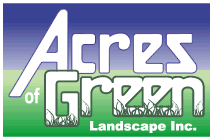There are some basics that every lawn needs in order to get healthy and stay healthy. If you don’t start with a solid foundation, every year is going to bring the renewed struggle to keep your yard looking great.
Professional Lawn Care
& Landscaping in Walpole, MA

Lawn Care Basics
Even when you’re doing everything right, caring for your lawn can be time consuming, and even if you know how to do everything correctly, you might be better off letting someone else take care of the work and spending more time just enjoying the results.
If you are a do-it-yourself kind of homeowner and don’t want to hire the pros at Acres of Green, these tips should give you a head start and help you keep your lawn looking great.
Watering
Different types of grass need different amounts of water. How much and how often to water also depends on how much sun and shade your lawn gets. These are guidelines, but if you’re not sure if they are exactly right for your yard, give us a call. We can assess your needs and give your lawn the loving care it deserves.
Don’t over water. Your lawn needs a little incentive to grow long, strong roots. If it is constantly saturated, it’ll lack that incentive. Water when it is needed. In most cases, watering two to three times each week is plenty. Ideally, you’ll want the water to reach about 7 inches deep into your soil. That doesn’t mean saturate the heck out of it. It means, about 7 inches down the soil should be moist after watering. Go ahead and dig in. That’s the only way to really know. If it is dry, adjust your watering time.
If your yard has a lot of hills and sloping areas, you’ve got more to consider. You’ll need to have an understanding of where water pools, how it runs down different grades, and how to adjust your watering accordingly.
Finally, don’t water in the middle of the day. You’ll lose a great deal of moisture to evaporation.
Fertilizing
A properly fertilized lawn is denser, so it looks better and does a better job of crowding out weeds and resisting bugs.
Choose the right spreader and use it correctly. Depending on the type of fertilizer you are using and the size of your lawn you may want to invest in a broadcast rotary spreader, while a drop spreader or handheld broadcast spreader would be a better choice for smaller lawns.
You’ll want to apply your fertilizer to a dry, but well-watered lawn. This might seem oxymoronic, but look back at our first tip about watering. If you’ve been watering correctly, even a day or two after you last watered, the ground under your lawn will be moist, while it is dry on the surface. That’s when you want to fertilize.
Nitrogen is the most important nutrient for your lawn. But it is also one of the biggest contributors to groundwater contamination in many parts of the country. So if you don’t know how much to use, or how to properly apply your nitrogen-rich fertilizer, leave it to the professionals. Your home compost is probably like a nitrogen super-supplement for your lawn, so be careful about using too much of it. Some areas have regulated the use of home compost for lawn fertilization because of its high nitrogen content. Be sure to check if you aren’t sure about the rules in your area.
If you follow the mowing instructions below, and only remove about the top ⅓ off the top of your grass, you can leave your clippings on your lawn which can reduce your need to add additional fertilizer by as much as 25 percent.
Mowing
Every lawn needs to be mowed. Well, almost every lawn—we’ll talk about that in another article. It seems simple, right? Just ride or push the mower over the lawn and let it do its thing.
It isn’t that simple. Do it wrong and your lawn won’t hold on to water or be able to combat weeds. It’ll be engaged in a daily struggle for its very survival. No one wants that. So follow these simple tips.
Keep it long. Cutting your grass too short leaves it susceptible to pests and weeds, and it doesn’t allow it to grow a root structure significant enough to support healthy growth. If you aren’t sure how short is too short for your lawn, give Acres of Green a call. We can get your lawn looking and feeling healthy in no time.
Mow dry grass. Mowing wet grass isn’t necessarily bad. It just isn’t going to look as nice when you’re done. And, if you’ve got dull blades, you’re going to have a tough time with wet grass. If you’re mowing a hill, or even a slight slope, never mow when the grass is wet. It is just dangerous. Slipping and sliding with a handheld or riding mower is not something anyone wants to deal with.
Cut, don’t tear. If your mower blades are dull, you’re going to be tearing your grass and leaving rough edges instead of making a smooth cut. Once again, you’re creating new opportunities for pests and diseases. Keep your mower blades sharpened.
Aeration
Aerating helps your lawn absorb nutrients and water. Here are a few tips. Mark the location of sprinkler heads, buried lines and other potential obstacles before you start. Leave the soil plugs alone afterward. They’ll decompose and add more nitrogen back into your lawn. Keep an eye out for weeds and consider taking some extra weed-control measures after aerating. Their roots can be brought to the surface and given more growing power too, and you don’t want to give them any help.
Spot Seeding And Overseeding
Sometimes things just happen. No matter how well you take care of your lawn, a neighbor’s dog, poor drainage, or other factors can lead to damage. When this happens, you’ll want to overseed or spot seed your lawn to restore those not-so-great looking patches. This sounds like an easy process, but there are so many factors involved in when to do it, how much seed to use, how to prepare for it, and more, that we could write an article just on this topic. Just call the professionals and let them handle it. They’ll get it right the first time and save you a lot of headaches and wasted time.
That brings us to the end of our lawn care basics overview. It sounds like a lot of work, doesn’t it? That’s because it is. If you want some help keeping your lawn looking great, just give us a call. It’s what we do.


